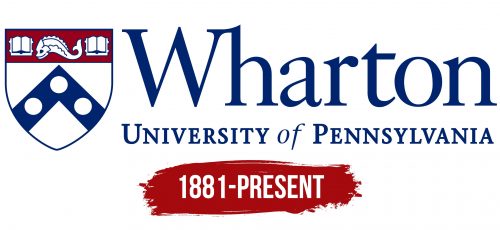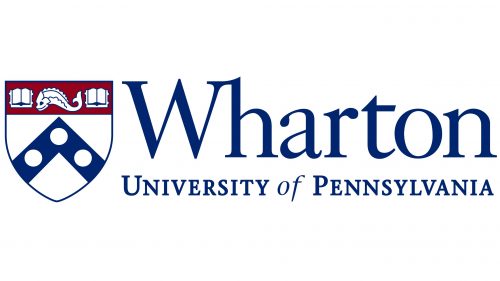The Wharton logo represents the identity of one of the world’s largest and most renowned business schools and reflects the institution’s unique characteristics. The logo elegantly presents the school’s name and incorporates the core values of the founding family.
Books, harps, and the eternal flame are frequently used to create identities for research centers and educational organizations. However, in the case of Wharton, the image of a dolphin is an unconventional symbol that draws attention and requires an explanation of its symbolic meaning.
Benjamin Franklin founded the world’s first business school, and the dolphin, a symbol of his family, was incorporated into his identity. The dolphin represents strength and the family’s traditions. Alongside the dolphin on the shield is a book, symbolizing knowledge, and another family emblem—three circles, representing the coat of arms of the founder of Pennsylvania, William Penn.
The Wharton logo is presentable, characterized by its unique style and vibrancy. It stands out for its informational richness and depth of content. Its graphic design, simplicity, and harmonious combination of colors and elements make it easily recognizable and memorable, giving it special significance and individuality.
Wharton: Brand overview
Established in 1881, the University of Pennsylvania’s Wharton School boasts a rich and illustrious history. Joseph Wharton, an American philanthropist and industrialist, gave $100,000 to start the first business school at a university in history.
Joseph Wharton recognized the need to establish a school that would train business executives to oversee the expanding industrial sector in the US. His concept included new fields like accounting and finance and the then-current traditional forms of education.
When it first opened as the “Wharton School of Finance and Economy,” only men were accepted. The first class had thirteen students. The program included cutting-edge entrepreneurship, industrial management, finance, and accounting classes.
The institution started adding courses in marketing and law to its curriculum in the 1890s. This was a groundbreaking move because these fields were not traditionally considered part of business education.
The school continued its innovative work in education into the early 1900s. In 1904, it founded the Industrial Research Unit, the first research department in a business school. This initiated a long-standing custom in business education of merging theory and practice.
The institution saw substantial expansion in the 1920s. The MBA program was introduced in 1921 and soon became one of the most prominent in the nation. At this time, the school also started accepting female students into its graduate programs.
The Great Depression of the 1930s greatly harmed the school. The institution changed its curriculum to reflect current economic conditions, focusing on public policy and economic regulation.
Following World War II, the school expanded quickly. The number of students rose significantly, with many veterans utilizing the G.I. Bill. The institution also started to broaden its foreign relationships during this time.
The school kept pushing the boundaries of education innovation in the 1950s and 60s. It introduced the first Executive MBA program in 1953 and pioneered the use of computers in the classroom when it started doing so in the 1960s.
The institution expanded its research endeavors throughout the 1970s. In 1973, the Sol C. Snider Entrepreneurial Research Center was established, among other new research centers.
During the 1980s and 90s, the school enhanced its standing as one of the top business schools worldwide. International exchange programs were started, and partnerships with colleges worldwide were formed.
The institution’s first campus outside the United States opened in San Francisco in 2001, deepening the university’s connections to the Silicon Valley startup scene and the technology industry.
The 2000s were marked by additional research and educational program expansion. In 2012, the institution debuted its first online course on the Coursera platform, opening its curriculum to students worldwide.
San Francisco hosted the institution’s first overseas campus in 2001. This allowed the school to expand its connections within the Silicon Valley startup community and the technology industry while providing the Executive MBA program on the country’s West Coast.
The Global Family Alliance program was established in 2002 to research and assist family companies worldwide.
The Global e-Management Initiative was established in 2003 to study how digital technologies affect business.
2007 was a momentous year as the new Jon M. Huntsman Hall, which housed the undergraduate and MBA programs, opened. This new facility greatly enhanced the school’s infrastructure and instructional environment.
The Innovation Fund was established in 2010 to encourage creative ideas from instructors and students.
The McNulty Leadership Program was established in 2011 to foster students’ leadership abilities.
2012, the institution started offering open-to-all online courses, making it one of the platform’s initial partners. This greatly increased the school’s impact worldwide.
The executive MBA program in San Francisco was established in 2013, increasing the institution’s prominence on the West Coast.
The People Analytics Initiative was founded in 2015 to enhance human resource management through data.
The launch of the Venture Lab in San Francisco in 2017 was noteworthy since it strengthened the school’s support for innovation and entrepreneurship.
The institution introduced the Penn Budget Model in 2018, offering unbiased economic evaluation of public policies.
The Stevens Center for Innovation in Finance was established in 2019 to utilize data analytics in the financial industry.
Despite worldwide issues in 2020, the school quickly adjusted to new conditions by growing its online services and switching to a hybrid learning methodology.
An innovative and technology-focused Executive MBA program was introduced in San Francisco in 2021, targeting leaders in these fields.
Additionally, the institution strengthened its relations abroad by forging new alliances with colleges and business schools across the globe and raising the quantity of student exchange programs.
The school has produced several illustrious alumni, including prominent politicians, business executives, and entrepreneurs. Elon Musk, Sundar Pichai, Warren Buffett, and numerous others are among them.
As a result, the school’s history is marked by constant innovation and adjustment to the shifting demands of society and business. As the first business school in history and a leader in business education worldwide, the institution will always be crucial in determining the next generation of corporate executives.
Meaning and History
What is Wharton?
It is a renowned business school, part of the University of Pennsylvania, and is known for its academic programs and influential research. Recognized as one of the world’s top universities in business education, Wharton offers doctoral, MBA, Executive MBA, and undergraduate programs. The institution is known for its challenging curriculum, strong faculty, and marketing, entrepreneurship, and finance programs. It has an extensive network of alums working in various fields and companies worldwide. State-of-the-art research centers, a trading floor that simulates real financial markets, and a host of career development services are among the resources available to students at this institution. It is often ranked among the top business schools in the world and attracts students from all over the world who want to improve their business skills and job prospects.
1881 – today
Blue, red, and white are the primary colors of the University of Pennsylvania’s identity. These colors harmonize well with each other, and in 1881, when the logo was created, they attracted considerable attention. The logo turned out to be quite colorful, which became its main advantage. It also stood out for its variety of fonts and abundance of images.
On the right, at the logo’s center, letters were placed that elegantly presented the university’s name. The words were written in three different fonts and arranged in two horizontal rows. An interesting feature was the italicized preposition. The two letters “of” stood out brightly against the background of the other elements, serving as a focal point that drew attention. All the words, except for the preposition, began with a capital letter. The font contained bright dotted elements for vowels and consonants, with large circles filled with blue paint serving as unique decorations for the text elements.
To the left of the text, written in a soft blue color, was a shield — the main symbol of this educational institution. The shield was divided into three zones. The upper part was highlighted with a red background, on which two books and a dolphin were placed. The books symbolized knowledge, and the dolphin, located in the center, was surrounded by them. The outlines of the images were blue, while the inner filling was white. In the lower part of the shield was a wide triangle, inside which three circles were arranged in an ascending line. Each circle was equally spaced from the others.
This shield contains over eight images, making it visually rich and attention-grabbing. The logo, used from 1881 to the present, testifies to the organization’s stability, adherence to traditions, and reliability. Today, Wharton Business School is an educational institution with a century and a half of history. The school’s motto: “Leges sine moribus vanae,” translates as: “Law without morals is nothing!”





